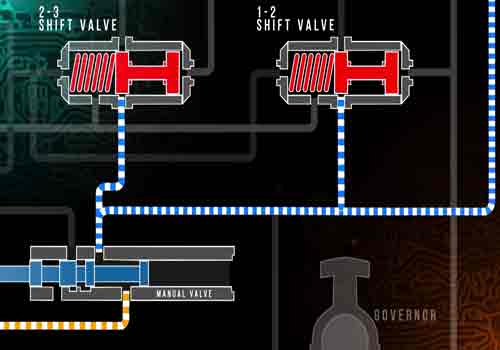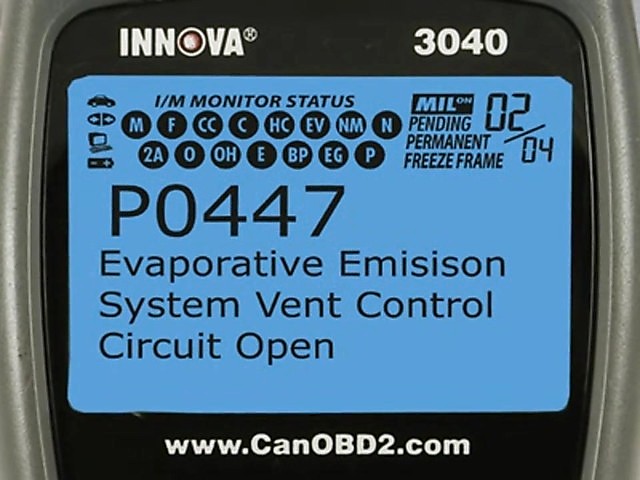P1595 Speed Control Solenoid Circuit Open Or Shorted
P1595 Speed Control Solenoid Circuit Open Or Shorted is a diagnostic trouble code (DTC) that indicates an issue with the speed control solenoid circuit. This DTC can be caused by either an open or shorted-in speed control solenoid circuit.
An open means there is no continuity between two points that should have it and a shorted condition means there is too much continuity between two points that shouldn’t have any.
In order to pinpoint the cause of this code, you will need to verify power and ground at the speed control solenoid, check for any broken wires or loose connections, use a multimeter to measure the resistance across all terminals of the speed control solenoid, and then remove and inspect it for signs of damage or failure. If no issues are found after these steps then the further diagnosis may be required.
If you’re having trouble with your car accelerating or decelerating, it could be a problem with the P1595 Speed Control Solenoid Circuit. This solenoid is responsible for controlling the speed of your vehicle, and when it isn’t working properly, you can experience issues while driving. The most common cause of this issue is that there’s an open or short circuit in the solenoid circuit.
This can lead to poor acceleration or deceleration performance from your vehicle, as well as other problems such as reduced fuel economy and increased emissions. It’s important to get this issue fixed quickly so that you don’t have any further complications down the road.
In order to diagnose this issue, mechanics will use special diagnostic tools to test all components of the system including sensors and wiring harnesses.
Once they’ve identified where exactly the problem lies within the solenoid circuit (either open or shorted), they’ll then be able to repair it accordingly either by replacing parts or fixing faulty wiring connections etcetera.

P1595 Jeep
If you’re looking for a reliable, powerful, and capable off-road vehicle, the Jeep P1595 might be just what you need. This robust 4×4 offers an impressive combination of performance and durability that makes it perfect for tackling any terrain. Here we will provide detailed information about this rugged ride so you can decide if it’s right for your needs.
The Jeep P1595 is based on the popular Jeep Grand Cherokee platform but with some serious modifications to make it ready for anything from light trails to full-on off-roading adventures. It features a 5.7 liter Hemi V8 engine which produces an impressive 360 horsepower at 5200 rpm and 390 lb.-ft of torque at 4000 rpm.
The powertrain also includes a four-wheel drive system with low-range gearing as well as electronic locking differentials in both front and rear axles making sure you have maximum traction no matter the situation or conditions encountered while out on your journey.
To ensure optimal handling, this beast comes standard with heavy-duty suspension components such as Bilstein shocks along with skid plates protecting its underbelly from rocks or other obstacles encountered while going through rough terrain.

Credit: ricksfreeautorepairadvice.com
Also Read: P1288 Intake Manifold Short Runner Solenoid Circuit Open Or Shorted
What is the P1595 Speed Control Solenoid Circuit
The P1595 Speed Control Solenoid Circuit is a critical component of modern vehicle engines. This circuit helps to regulate the speed of the engine, ensuring that it runs at an optimum level and does not overheat or damage any other components. The solenoid itself is a device that controls hydraulic pressure in order to vary the position of an object such as a valve, allowing for precise control over engine speed.
In vehicles with automatic transmissions, this type of solenoid circuit helps adjust shift points and can be used to increase fuel efficiency by allowing for more gradual acceleration and deceleration.
It also prevents the transmission from shifting too early or late, which can cause excessive wear on internal parts and reduce overall performance. To ensure proper operation of this circuit, it must be connected correctly within the wiring harness to provide power when required.
If improperly connected or if there are loose wires in the system, then sudden changes in engine speed might occur due to a lack of sufficient voltage being supplied at certain times. In some cases, this could lead to complete failure if left unchecked for an extended period of time due to overheating caused by strain on other components within the system.
The P1595 Speed Control Solenoid Circuit is an Electronic Component That Helps Regulate the Flow of Fluid to And from a Vehicle’S Transmission System, Allowing for Smoother Shifts And Better Performance
The P1595 speed control solenoid circuit is an essential component of a vehicle’s transmission system. It regulates the flow of fluid to and from the transmission, allowing for smoother shifts and better performance. The solenoid works by using electronically-controlled valves that open or close depending on what type of shift needs to be made.
The primary benefit of having a P1595 speed control solenoid circuit in place is improved shifting capability. When a certain amount of pressure is applied to the transmission, this causes a chain reaction that opens or closes these valves accordingly, which helps regulate the flow of fluid more efficiently than manual shifting would allow. This ultimately leads to smoother gear changes and increases overall performance levels while driving.
In addition to increased performance levels, another advantage provided by installing this part is reduced fuel consumption as it takes less time for gears to engage when transitioning from one gear ratio to another due to quicker valve activation and deactivation times.
Furthermore, noise generated from inefficient shifting can also be greatly reduced as there are fewer instances where gears will grind against each other during transitions with this system installed compared to without it being present in your car’s engine setup.
What Causes a P1595 Speed Control Solenoid Circuit to Become Open Or Shorted
If your vehicle is exhibiting symptoms of a failed Speed Control Solenoid Circuit, you may be wondering what could have caused it to become open or shorted.
The Speed Control Solenoid Circuit (P1595) is responsible for controlling the speed of the engine and its associated systems. This solenoid circuit can become damaged due to wear and tear over time or because of an external cause such as corrosion, improper installation, electrical shorts/opens, etc.
The most common cause of an open or shorted P1595 Speed Control Solenoid Circuit is due to corrosion on the connections.
Corrosion can build up between wires and terminals inside the circuit board causing them to break apart which will lead to an open circuit condition resulting in no power being supplied to the circuit’s components. If this happens, then all associated systems including fuel delivery, ignition timing control, spark advance/retard system, etc., will not function properly leading to poor engine performance and misfiring.
A Faulty Wiring Connection, Worn Out Or Defective Solenoids, Or an Electrical Fault in Any Related Components Can Cause a P1595 Speed Control Solenoid Circuit to Become Open Or Shorted
When it comes to diagnosing issues with your vehicle, a P1595 speed control solenoid circuit may be the culprit. A faulty wiring connection, worn out or defective solenoids, or an electrical fault in any related components can cause a P1595 speed control solenoid circuit to become open or shorted. The first step in troubleshooting this issue is determining if the trouble code is caused by an open or shorted condition in the circuit.
If you are using a scan tool and see that the code indicates either an open or shorted condition for the P1595 speed control solenoid circuit, then you will need to perform further diagnostic tests. To begin testing for an open condition on your vehicle’s P1595 speed control solenoid circuit, start by disconnecting all of its associated connectors and checking them for corrosion.
Corrosion can be indicative of water intrusion into the connector which could lead to poor connections and eventual failure of some of its components within time.
Once done cleaning any corroded connectors move on to testing each wire individually with a multimeter set at Ohms (Ω).
How Do I Know If My Car Has This Issue
If you suspect your car has an issue, it can be difficult to know for sure without the help of a professional. To determine if your car has an issue, there are several steps you should take before bringing it in for repairs. First, check the dashboard lights and warning signs.
Most modern cars have warning indicators that light up when something is wrong with the vehicle’s systems or components such as low oil pressure, brakes being worn down, or other problems.
Pay attention to these lights and make note of any issues they indicate so that you can provide more information when speaking to a mechanic about your car’s problem. Second, inspect your car visually for any obvious damage or malfunctioning parts.
Take some time to go around and look closely at all areas of the exterior and interior of your vehicle including tires, headlights/taillights, wipers, etc., as well as underneath the hood to see if anything looks out of place or not functioning correctly like a loose belt or broken hose clamp on one side but not another.
Check Your Vehicle’S Diagnostic Codes With an Obd-Ii Scanner; If It Reports Error Code “P1595 – Speed Control Solenoid Circuit Open/Shorted” Then You Likely Have This Issue Present on Your Car As Well As Other Associated Issues Such As Poor Shifting And Reduced Power Output from the Engine Due to Lack of Proper Fluid Flow Regulation within the Transmission System
If you’ve ever experienced problems with shifting gears or decreased power output from your engine, then it’s likely that your car is suffering from a problem known as the P1595 – Speed Control Solenoid Circuit Open/Shorted error code.
This particular issue occurs when the electrical circuit responsible for controlling the speed of fluid flow within the transmission system has either become shorted out or opened up due to some sort of failure in components such as wiring and connectors. Fortunately, this error code can be easily diagnosed using an OBD-II scanner.
The process simply involves plugging the device into your vehicle’s onboard diagnostic port (located under the dashboard) and allowing it to read any available trouble codes stored in its computer memory banks.
Once connected, if your OBD-II scanner reports back with a “P1595 – Speed Control Solenoid Circuit Open/Shorted” then you will know that this is indeed what is causing your issues with shifting gears and reduced engine power output due to lack of proper fluid flow regulation within your transmission system.
Transmission No Shift Case Study (P0888)
Conclusion
Having trouble with your vehicle’s speed control solenoid? It could be that the circuit is open or shorted. This can happen when there’s a break in the electrical connection, either due to corrosion or physical damage.
If this happens, you may notice issues such as difficulty accelerating, poor fuel economy, and transmission slipping out of gear. To diagnose this issue correctly and avoid potential further problems down the line, it’s important to have an experienced mechanic check things out.
They’ll use a diagnostic scan tool to identify any codes associated with P1595 (Speed Control Solenoid Circuit Open/Shorted) before determining if repairs are necessary.
Once they’ve established what needs repairing, they’ll be able to get you back on the road safely and quickly!